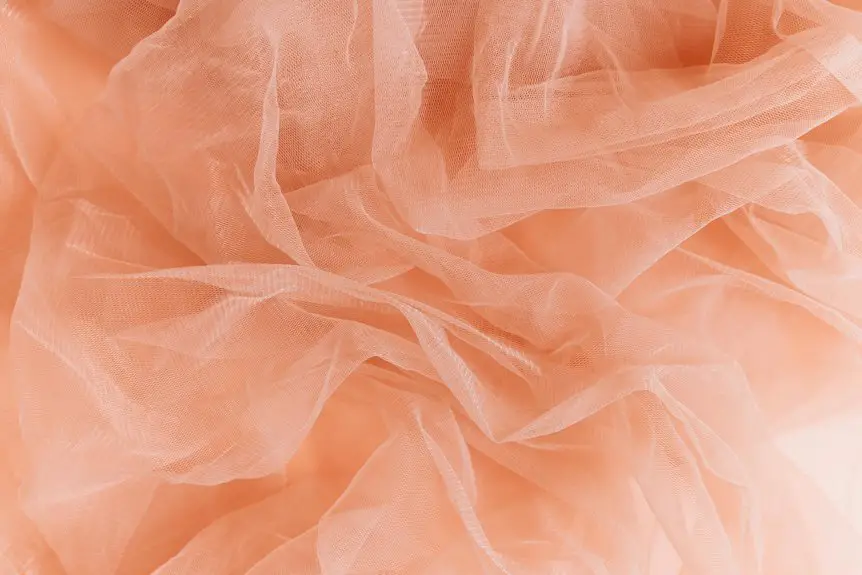Gauze fabric ranges from sheer, lightweight types around 40-60 GSM, offering airy breathability and softness, to heavyweight versions with tighter weaves that provide durability and structure. Lighter gauzes feel delicate and perfect for warm weather or layering, while medium and heavyweight options support sturdier garments or durable projects. Your choice should match your project’s needs for softness, breathability, or robustness. Explore more about each weight’s benefits and care tips to pick the ideal gauze.
Table of Contents
Key Takeaways
- Gauze fabric weight is measured in GSM or oz/yd², with lightweight gauze around 40-60 GSM or 1.2-1.8 oz/yd².
- Lightweight gauze is sheer, breathable, and soft, ideal for summer clothing and baby wraps but requires gentle care to avoid damage.
- Medium-weight gauze balances durability and breathability, suitable for structured garments needing a gentle drape.
- Heavyweight gauze has a dense weave, providing durability, shape retention, and protection for more rugged applications.
- Choosing the right gauze weight depends on project needs, with care instructions varying from delicate washing for light gauze to sturdier handling for heavy gauze.
What Is Gauze Fabric?
Gauze fabric is a lightweight, loosely woven material known for its breathable and sheer qualities. When you work with gauze, you’ll notice its airy texture, which makes it perfect for warm weather clothing, curtains, or medical dressings.
It’s typically made from cotton, but you can also find gauze in silk, wool, or synthetic fibers. Because of its open weave, gauze feels soft and flexible, allowing air to pass through easily.
You’ll appreciate how this fabric drapes gently, providing comfort without feeling heavy. Its delicate appearance doesn’t mean it’s fragile; gauze is surprisingly durable when handled properly.
Understanding what gauze is helps you choose the right weight and type for your specific project or need.
How Fabric Weight Is Measured
You’ll often see fabric weight measured in grams per square meter (GSM) or ounces per square yard.
Remember, weight isn’t the same as thickness, but both affect how the fabric feels and performs.
Understanding these measurements helps you choose the right gauze for your specific needs.
Units of Measurement
Two common units measure fabric weight: grams per square meter (gsm) and ounces per square yard (oz/yd²). When you see gsm, it tells you the weight of one square meter of fabric in grams. This metric system unit is widely used internationally, especially in Europe and Asia.
On the other hand, oz/yd² measures how many ounces one square yard of fabric weighs, a system popular in the United States.
Understanding these units helps you compare fabric weights accurately, regardless of where the fabric comes from. Lighter gauze might’ve a gsm around 40-60 or an oz/yd² around 1.2-1.8, while heavyweight gauze could be much higher.
Weight Vs Thickness
Knowing the weight of fabric in gsm or oz/yd² gives you a solid idea of its density, but weight alone doesn’t tell the full story about how thick or heavy the fabric feels.
Thickness depends on factors like yarn type, weave, and finish. For example, a loosely woven gauze might weigh less but feel thicker due to air trapped between fibers. Conversely, a tightly woven fabric with the same weight can feel thinner and denser.
When you measure fabric weight, you’re looking at mass per unit area, but thickness measures the physical depth. They don’t always correlate directly.
Impact on Usage
Although gauze fabric weight is just one factor, it plays an essential role in determining how you’ll use the material.
Fabric weight is typically measured in grams per square meter (GSM) or ounces per square yard (oz/yd²). These measurements help you understand the fabric’s density and thickness, influencing durability, breathability, and drape.
When you choose lightweight gauze, you get a sheer, airy fabric ideal for scarves or summer clothing. Heavier weights provide more structure, perfect for upholstery or outerwear.
Knowing the weight guides you in matching the fabric to your project’s needs, ensuring the right balance between comfort and functionality.
Characteristics of Sheer Gauze
Sheer gauze offers a delicate transparency that lets light pass through while maintaining a subtle texture.
Delicately transparent, sheer gauze allows light to shine through while preserving a gentle, understated texture.
When you handle sheer gauze, you’ll notice its lightweight, airy feel that makes it incredibly breathable. Its open weave structure creates tiny gaps between threads, giving it that translucent appearance.
You’ll find the fabric soft to the touch, yet slightly crisp, which helps it hold gentle folds and drapes beautifully without weighing down.
Because of its fine construction, sheer gauze can be somewhat fragile, so you’ll want to handle it carefully to avoid snags or tears.
The fabric’s texture adds visual interest without overwhelming designs, making it perfect when you want subtle elegance combined with lightness and flow.
Lightweight Gauze Uses and Benefits
You’ll find lightweight gauze perfect for summer clothing, curtains, and baby wraps thanks to its sheer quality.
It offers excellent breathability, keeping you cool and comfortable in warm weather.
Plus, its soft texture makes it gentle on your skin for everyday use.
Common Lightweight Applications
When you choose lightweight gauze fabric, you tap into its versatility and breathability, perfect for a range of applications.
You’ll find it ideal for making summer clothing like blouses, scarves, and dresses that keep you cool without sacrificing style. Lightweight gauze is also excellent for baby blankets and swaddles, offering gentle softness against sensitive skin.
If you enjoy crafting, it works well for decorative accents such as curtains, table runners, or gift wraps, adding a delicate touch.
Additionally, this fabric’s airy quality makes it a favorite for layering in home textiles, where light filtering and softness matter.
Whether you’re sewing for comfort or aesthetics, lightweight gauze adapts effortlessly to your needs, balancing function with elegance.
Advantages of Sheer Fabric
Anyone looking for a fabric that combines lightness with style will appreciate the advantages of lightweight gauze. This sheer fabric offers a delicate, airy appearance that instantly elevates your designs with elegance.
You’ll find it easy to layer, adding texture without bulk, perfect for creating flowy garments or decorative accents. Its semi-transparency allows you to play with light and shadow, enhancing visual interest in your projects.
Plus, lightweight gauze drapes beautifully, giving your creations a soft, natural movement. It’s also versatile enough for both casual and formal uses, making it a reliable choice for various styles.
When you pick sheer gauze, you’re choosing a fabric that’s as fashionable as it’s functional, ideal for adding subtle charm.
Breathability and Comfort Benefits
Although lightweight gauze looks delicate, it offers impressive breathability that keeps you comfortable in warm weather. The open weave allows air to circulate freely, preventing overheating and moisture buildup. This makes it ideal for clothing, scarves, and summer accessories. You’ll appreciate how soft and gentle it feels against your skin, reducing irritation on hot days. Plus, its lightweight nature means you can layer without feeling weighed down.
| Feature | Benefit | Ideal Use |
|---|---|---|
| Open Weave | Enhanced airflow | Summer clothing |
| Soft Texture | Skin-friendly comfort | Baby wraps, scarves |
| Lightweight | Easy layering | Casual wear |
This balance of breathability and comfort makes lightweight gauze a versatile fabric for warm climates.
Medium Weight Gauze: Versatility in Design
A medium weight gauze strikes the perfect balance between durability and breathability, making it an ideal choice for a wide range of design projects.
You’ll find it versatile enough to handle both casual and more structured garments without sacrificing comfort. Its texture offers enough substance to hold shape while still feeling light against the skin, giving you flexibility in style and function.
Consider using medium weight gauze for:
- Flowing dresses and skirts that need a bit of structure
- Lightweight jackets or layering pieces
- Home décor items like curtains that filter light gently
- Baby blankets that require softness with durability
- Accessories such as scarves that balance warmth and breathability
This fabric weight lets you get creative without compromising on wearability.
Heavyweight Gauze for Durability
Three key benefits make heavyweight gauze a top choice when durability is your priority. First, its dense weave resists wear and tear, ensuring long-lasting use. Second, heavyweight gauze maintains shape and structure better than lighter options. Third, it offers enhanced protection, making it ideal for applications requiring toughness.
Here’s a quick comparison to help you understand its characteristics:
| Feature | Heavyweight Gauze | Medium Weight Gauze |
|---|---|---|
| Durability | High | Moderate |
| Thickness | Thick | Medium |
| Ideal Use | Protective coverings | Versatile garments |
| Shape Retention | Excellent | Good |
| Wear Resistance | Superior | Moderate |
Choosing heavyweight gauze means you won’t have to compromise on strength and longevity.
Comparing Breathability Across Gauze Weights
While heavyweight gauze offers impressive durability, it can sometimes compromise on breathability. When you compare different gauze weights, you’ll notice lighter fabrics allow more air to pass through, keeping you cooler.
Sheer gauze is ideal for warm climates or layering, while medium weights strike a balance between airflow and structure. Heavyweight gauze, though less breathable, works well when you need more warmth or coverage.
Consider these key breathability factors:
- Weave density: Looser weaves increase airflow.
- Fabric layers: Multiple layers reduce breathability.
- Weight: Lighter weight equals better ventilation.
- Fiber type: Natural fibers tend to breathe better.
- Intended use: Breathability needs vary by project.
Understanding these helps you pick gauze that matches your comfort needs perfectly.
Choosing the Right Gauze Weight for Your Project
When selecting gauze for your project, consider how the fabric’s weight will impact its function and feel. If you want something light and airy, choose a sheer or lightweight gauze for maximum breathability and softness.
For a bit more structure without sacrificing comfort, a medium-weight gauze works well in clothing or home decor, offering durability with a gentle drape. Heavyweight gauze suits projects needing extra warmth or sturdiness, like outerwear or upholstery.
Also, think about how the fabric will move and wear over time. If your project requires layering or a delicate touch, lighter gauze is ideal. For something more robust or long-lasting, heavier gauze fits better.
Matching the gauze weight to your project guarantees the end result performs exactly as you want it to.
Caring for Different Gauze Fabric Weights
Because gauze fabric varies in weight, you’ll need to adjust your care routine to keep each type in great condition.
Lightweight gauze requires gentle handling to prevent tearing, while heavyweight gauze can tolerate a bit more robust care.
Always check the fabric label, but here are some general tips to help you care for gauze fabric effectively:
- Wash lightweight gauze on a delicate cycle with cold water to avoid shrinkage.
- Use mild detergent to protect the fabric’s softness.
- Avoid wringing out lightweight gauze; instead, gently squeeze out excess water.
- For heavyweight gauze, machine washing is usually safe, but use cold or lukewarm water.
- Air dry gauze fabrics flat or hang them to maintain their shape and texture.
Following these tips will help your gauze fabric stay fresh and durable.
Frequently Asked Questions
Can Gauze Fabric Be Dyed at Home?
Imagine you want to refresh an old gauze scarf. You can dye gauze fabric at home easily using fiber-reactive dyes. Just soak, dye, rinse, and dry—it’s fun and gives your fabric a vibrant new look!
Is Gauze Fabric Hypoallergenic?
You’ll find gauze fabric is generally hypoallergenic because it’s lightweight and breathable, reducing irritation. However, always check the fiber content and dye used, since some additives might cause sensitivity if you have allergies.
What Is the Environmental Impact of Gauze Production?
Like treading lightly in a forest, you’ll find gauze production varies—cotton gauze demands water and pesticides, while organic or bamboo fibers lessen harm. Choosing eco-friendly options helps you protect the planet while crafting comfort.
Can Gauze Fabric Be Used for Upholstery?
You can use gauze fabric for upholstery, but it’s not ideal. Gauze is lightweight and delicate, so it won’t hold up well to heavy wear or provide much durability compared to traditional upholstery fabrics.
How Does Gauze Fabric Perform in Waterproofing?
You might expect gauze to repel water, but it doesn’t—its loose weave soaks through quickly. So, if you want waterproof fabric, gauze isn’t your best bet unless you add a special coating or liner first.
- Tetron Fabric for Marine Applications: Durability and Use Cases - June 18, 2025
- Tetron Fabric for Outdoor Furniture: Weather Resistance and Care - June 18, 2025
- Tetron Fabric for Wall Coverings: Style and Application Tips - June 18, 2025






